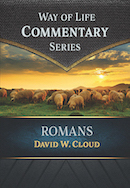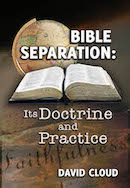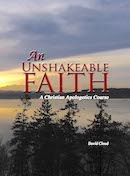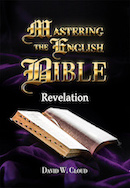866-295-4143, fbns@wayoflife.org
Since 1979 her works have enjoyed a revival through the contemplative movement. She is promoted by Richard Foster, who includes an entire chapter by her in his book Spiritual Classics. She is also promoted by Matthew Fox, the New Age priest who was ordained as an Episcopalian after being forced out of the Catholic priesthood.
She was put in a Benedictine monastery at age eight to be educated by Jutta von Spanheim, the abbess of the monastery who was an anchoress and practiced silent contemplation. As part of her asceticism an anchoress was devoted to live in a little cell next to a church for her entire life. There was only one door and a little window through which her food and other necessities were passed. The door was commonly locked from the outside, with only one or two people having a key and visitation privileges. They were even called prisons.
“Anchors of both sexes, though from most accounts they seem to be largely women, led an ascetic life, shut off from the world inside a small room, usually built adjacent to a church so that they could follow the services, with only a small window acting as their link to the rest of humanity. Food would be passed through this window and refuse taken out. Most of the time would be spent in prayer, contemplation, or solitary handworking activities, like stitching and embroidering. Because they would become essentially dead to the world, anchors would receive their last rights from the bishop before their confinement in the anchorage. This macabre ceremony was a complete burial ceremony with the anchor laid out on a bier” (“The Life and Works of Hildegard,” http://www.fordham.edu/halsall/med/hildegarde.html).
At age 15 Hildegard became a Benedictine nun.
Her extreme asceticism went far beyond merely being locked into an anchorite cell. Her “strict practices of fasting and self-punishment, resulted in a lifetime of health problems and migraine headaches” (John Talbot, The Way of the Mystics, p. 55). She recommended constant fasting, abstinence from meat, and “maceration of the flesh and heavy beatings” as the means of overcoming fleshly desires.
Hildegard is alleged to have had visions from age three to the end of her life. She claimed that by means of the visions she gained the ability to “understand, without any human teaching, the writings of the prophets, the evangelists and of other holy men and those of certain philosophers” (Sabina Flanagan, Hildegard of Bingen, p. 43).
At age 47 she supposedly received a command from God to write down the visions, and for the next ten years she did so with the help of various secretaries, including a monk named Volmar. She was encouraged in this task by Bernard of Clairvaux, who influenced the pope to approve of her visions. She called them “the secret mysteries of God.”
Her visions are contained in three books, Scivias (Know the Ways), Liber vitae meritorum (Book of Life’s Merits), and Liber dioinorum operum (Book of the Divine Works).
Hildegard said that while in vision she lost all bodily sensation.
“At a later time I saw a mysterious and wonderful vision so that my inmost core was convulsed and I lost all bodily sensation, as my knowledge was altered to another mode, unknown to myself” (Flanagan, Hildegard of Bingen, p. 141).
She allegedly saw images of each person in the Godhead, which the Bible says is impossible (John 1:18; 4:46).
She said that God told her that men should confess their sins into “the ear of the priest” (auricular confession) and the priest “is the judge in place of my Son” (Book of Life’s Merits, I, chapt. 79).
She saw the Roman Catholic Church covered with the blood of Christ, even though it denies His gospel of grace, perpetually offers Christ anew on its altars, worships him in a piece of bread, and exalts Mary at least as highly as Christ.
She claimed that marriage was a result of man’s fall, whereas the Bible says marriage was instituted by God before the fall (Genesis 2:20-25). God had instructed the man and woman to be fruitful and multiply before the fall (Gen. 1:27-28).
She claimed that God told her that the forbidden fruit was the apple (Scivias, I, vision 2, chapter 13). In fact, it was the fruit of a unique tree called the “tree of the knowledge of good and evil” (Gen. 2:16-17).
She falsely claimed that the end of history was at hand in her day.
Like some of the other Catholic mystics, Hildegard included the female element in her understanding of God (Christian Mystics, p. 82).
She was deeply committed to devotion to Mary and dedicated many songs to her, including one entitled “Praise for the Mother.”
Hildegard’s visions described purgatory, even though there is no such teaching in Scripture, and in fact Scripture says that sins are purged fully and only by the cross of Jesus Christ. She described purgatory as a place of fire, a stinking marsh, punishing spirits, fiery thorns, spikes, toads, horrible worms, vipers, and scorpions.
Following are two of her visions of purgatory:
“For the torments of these punishments purge the souls, who, living in the transitory world deserved there the purgation of their sins through punishment in the non-transitory [world]. They were not fully purged in the flesh, having been prevented by death, or even tried in the world by the divine flails of compassionate God. Therefore they will be purged by these punishments, unless they are snatched from them by the labours of men and the virtues of the saints, which God worked in them through the invocation of the piety of divine grace” (Book of Life’s Merits, I, chapt. 77, cited from Flanagan, Hildegard of Bingen, p. 77).
“And I saw a horrendous place, full of fiery thorns and spikes and horrible worms, through which wicked spirits harried with fiery whips the souls of those who while they were in their bodies in the world stood for all kinds of injustice. And because they upheld injustice in word and deed, they are punished with thorns and spikes; and since they preserved bitterness in it, they are tortured by worms; and since they were merciful to no one through injustice they are afflicted by the wicked spirits with fiery whips. And I saw and understood these things” (Book of Life’s Merits, IV, chapt. 43).
Hildegard believed that souls could be rescued from purgatory through “the recitation of psalms for the dead, almsgiving, prayers, and other holy works.”
She believed that man is one with the universe.
“O man, look to man. For man has the heavens and earth and other created things within him. He is one, and all things are hidden within him” (Causae et curae, I, chapt. 4).
Hildegard even wrote on health issues and prescribed remedies. Her works on medicine and science were published under the titles Physica (Natural History) and Causae et curae (Causes and Cures). They are known collectively as Subtilitates diversarum naturarum creaturarum (The Subtleties of the Diverse Natures of Created Things).
Her medical works are still consulted in the alternative health movement, but they are unscientific in the extreme, involving curative stones, incantations, and prescriptions of various herbs, etc., with the objective of balancing the “humours in the body,” which is an occultic rather than a scientific view.
“Her views were derived from the ancient Greek cosmology of the four elements--fire, air, water, and earth--with their complementary qualities of heat, dryness, moisture, and cold, and the corresponding four humours in the body--choler (yellow bile), blood, phlegm, and melancholy (black bile). Human constitution was based on the preponderance of one or two of the humours. Indeed, we still use words ‘choleric’, ‘sanguine’, ‘phlegmatic’ and ‘melancholy’ to describe personalities. Sickness upset the delicate balance of the humours, and only consuming the right plant or animal which had that quality you were missing, could restore the healthy balance to the body. That is why in giving descriptions of plants, trees, birds, animals, stones, Hildegard is mostly concerned in describing that object’s quality and giving its medicinal use. Thus, ‘Reyan (tansy) is hot and a little damp and is good against all superfluous flowing humours and whoever suffers from catarrh and has a cough, let him eat tansy. It will bind humors so that they do not overflow, and thus will lessen’” (“The Life and Works of Hildegard,” http://www.fordham.edu/halsall/med/hildegarde.html).
Jewel therapy formed a significant part of Hildegard’s medical practice.
“[The emerald] is a specific for pain in the heart, stomach, or side, epilepsy, headache, colds, and sores. The cure is effected by external application in most cases, although sometimes just looking at the jewel while repeating a religious charm will produce the desired effect; alternatively, it can be placed in wine which is then drunk.
“... Hildegard’s account is heavily biased towards their magical qualities. Thus the sapphire can be used to improve intellectual powers if held in the mouth for a short while on rising in the morning, or used to free those possessed by malignant spirits if hung in a bag round the neck. Topaz indicates the presence of poison in food, and so should be worn in a ring and frequently inspected. However, even these virtues are somehow connected with the amount of heat or cold possessed by the stone, thus ‘Alabaster is not rightly hot or cold, but is lukewarm and so it is that there is almost no medical use for it’” (Flanagan, Hildegard of Bingen, p. 87).
For “libidinous cravings,” she recommended the sparrowhawk. The grease was to be caught during the cooking process and mixed with other things. If the woman put some of this in her naval, her “ardor” would be gone in a month (Physica, VI, chap. 20)!
For epileptic seizure, she recommended tying glowworms in a cloth and placing it on the stomach.
For jaundice, the sufferer must tie a bat onto his back and then onto his stomach until it dies.
Deafness is cured by placing a lion’s ear on the deaf person’s ear.
Baldness is cured by spreading bear’s grease mixed with the ash of wheat straw on the head and leaving it there as long as possible.
Drunkenness is cured by dunking a small female dog in water and using that water to bathe the head.
For an infestation of fleas, the sufferer is instructed to dry some dirt by heating it in a vessel and then sprinkle it on his bed, “and when the fleas sense the dryness they cannot stand it and depart and perish, and thus one can have peace from them.”
For a suspected poisoning, she recommended that powdered steel be placed in the person’s food. This “will attenuate the poison, although the person who eats it may still fall ill.”
As a preventative against poisoning, she suggested making a potpourri of certain dried plants and smelling it every day.
Hildegard even mentions the mythical “griffin” (a cross between a lion and an eagle) in her list of 72 birds and insects.
___________________________________________________
The preceding is excerpted from the book CONTEMPLATIVE MYSTICISM: A POWERFUL ECUMENICAL BOND, which is available from Way of Life Literature. Contemplative mysticism, which originated with Roman Catholic and Greek Orthodox monasticism, is permeating every branch of Christianity today, including the Southern Baptist Convention. In this book we document the fact that Catholic mysticism leads inevitably to a broadminded ecumenical philosophy and to the adoption of heresies. For many, this path has led to interfaith dialogue, Buddhism, Hinduism, universalism, pantheism, panentheism, even goddess theology. One chapter is dedicated to exposing the heresies of Richard Foster: “Evangelicalism’s Mystical Sparkplug.” We describe the major contemplative practices, such as centering prayer, visualizing prayer, Jesus Prayer, Lectio Divina, and the labyrinth. We look at the history of Roman Catholic monasticism, beginning with the Desert Fathers and the Church Fathers, and document the heresies associated with it, such as its sacramental gospel, rejection of the Bible as sole authority, veneration of Mary, purgatory, celibacy, asceticism, allegorical interpretation of Scripture, and moral corruption. We examine the errors of contemplative mysticism, such as downplaying the centrality of the Bible, ignoring the fact that multitudes of professing Christians are not born again, exchanging the God of the Bible for a blind idol, ignoring the Bible’s warnings against associating with heresy and paganism, and downplaying the danger of spiritual delusion.
A major section of the book is entitled “A Biographical Catalog of Contemplative Mystics” which deals with dozens of the current-day contemplative promoters as well as the ancient “saints” and mystics that are being resurrected today, including the following:
Angela of Foligno, Anthony the Great, Augustine, Benedict of Nursia, Bernard of Clairvaux, Ken Blanchard, Bonaventure, Brother Lawrence, Catherine of Genoa, Catherine of Siena, Larry Crabb, Anthony De Mello, Dominic, Meister Eckhart, Tilden Edwards, James Finely, Richard Foster, Matthew Fox, Frances de Sales, Francis of Assisi, Alan Griffiths, Madame Guyon, Hildegard of Bingen, Ignatius of Loyola, Willigis Jager, John of the Cross, William Johnston, Julian of Norwich, Thomas Keating, Morton Kelsey, Thomas a Kempis, Sue Monk Kidd, Peter Kreeft, John Main, Brennan Manning, Thomas Merton, J.P. Moreland, Henri Nouwen, Basil Pennington, Eugene Peterson, Karl Kahner, Thomas Ryan, William Shannon, Henri Le Saux, Philip St. Roman, David Steindl-Rast, Henry Suso, John Michael Talbot, Johann Tauler, Wayne Teasdale, Pierre Teilhard, Teresa of Avila, Teresa of Lisieux, Majorie Thompson, Phyllis Tickle, Robert Webber, Dallas Willard, John Yungblut
The book contains an extensive index.
- Receive these reports by email
- www.wayoflife.org
______________________
Sharing Policy: Much of our material is available for free, such as the hundreds of articles at the Way of Life web site. Other items we sell to help fund our expensive literature and foreign church planting ministries. Way of Life's content falls into two categories: sharable and non-sharable. Things that we encourage you to share include the audio sermons, O Timothy magazine, FBIS articles, and the free eVideos and free eBooks. You are welcome to make copies of these at your own expense and share them with friends and family. You may also post parts of reports and/or entire reports to websites, blogs, etc as long as you give proper credit (citation). A link to the original report is very much appreciated as the reports are frequently updated and/or expanded. Things we do not want copied and distributed are "Store" items like the Fundamental Baptist Digital Library, print editions of our books, electronic editions of the books that we sell, the videos that we sell, etc. The items have taken years to produce at enormous expense in time and money, and we use the income from sales to help fund the ministry. We trust that your Christian honesty will preserve the integrity of this policy. "For the scripture saith, Thou shalt not muzzle the ox that treadeth out the corn. And, The labourer is worthy of his reward" (1 Timothy 5:18). Questions? support@wayoflife.org
Goal:Distributed by Way of Life Literature Inc., the Fundamental Baptist Information Service is an e-mail posting for Bible-believing Christians. Established in 1974, Way of Life Literature is a fundamental Baptist preaching and publishing ministry based in Bethel Baptist Church, London, Ontario, of which Wilbert Unger is the founding Pastor. Brother Cloud lives in South Asia where he has been a church planting missionary since 1979. Our primary goal with the FBIS is to provide material to assist preachers in the edification and protection of the churches.
Offering: Offerings are welcome if you care to make one. If you have been helped and/or blessed by our material offerings can be mailed or made online with with Visa, Mastercard, Discover, or Paypal. For information see: www.wayoflife.org/about/makeanoffering.html.





